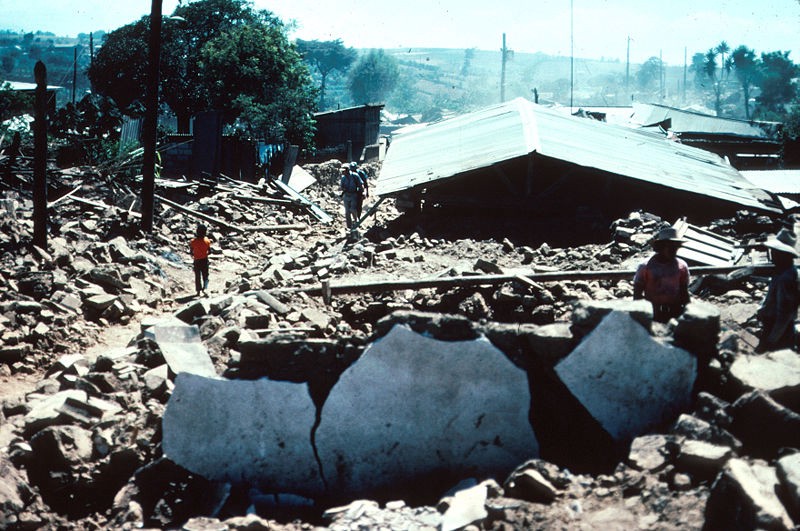Disasters by Design?
“Medical statistics will be our standard of measurement: we will weigh life for life and see where the dead lie thicker, among the workers or among the privileged.” — Rudolf Virchow, 1848
By Will Pollock
We call them “natural” disasters, painting ourselves as helpless victims of the forces of dispassionate Nature. Such label is convenient — by it we absolve ourselves of social and legal responsibility. But is it honest?
There is some truth to it. Surely Nature plays no favorites. Earthquakes and droughts strike the rich and poor, dominant and marginalized alike. But the damages that follow a natural, hazardous process — such as an earthquake, tsunami, or landslide — appear eerily “un-natural.” Mortality statistics show that it is those in the basement of social stratification who lose the most when Nature wreaks havoc. A re-examination of recent and historical disasters points to humans, not Nature, as the “designers” of disaster.
1976. Slide 43, U.S. Geological Survey Open-File Report 77–165.
On 04 February 1976 a magnitude 7.5 earthquake rattled Guatemala City. Whole neighborhoods were leveled and 22,000 people were killed among rural and urban squatter settlements. Meanwhile, the middle and upper classes weathered the quake virtually untouched. The earthquake fatalities mirrored not only economic but also ethnic divisions, with many of the rural casualties among indigenous Mayans. The discriminant patterns of damage led to coining of the phrase “class-quake”[1].
Fast forward 42 years. In the largest refugee crisis since World War II, 12 million Syrians have been displaced by the ongoing Syrian crisis, many of whom have flocked to neighboring Lebanon, overwhelming its tiny pre-crisis population of 4 million. Pressures of space and resources have created vast economic and social disparities between refugees and the communities which host them. Disaster forecasts estimate that impoverished Syrian refugees living in informal shelters are nine times more likely to be killed by debris flows than their Lebanese neighbors[2].
The corresponding trends of marginalization and disaster damages are global. The United Nations Development Program notes that “while only 11 percent of the people exposed to natural hazards live in low human development countries, they account for more than 53 percent of the recorded deaths”[3].
How can indiscriminate natural forces create highly discriminating damages?
The answer lies in the concept of social vulnerability. Social vulnerability describes an increased sensitivity to the adverse effects of natural hazards, created by a mix of physical and socio-economic factors: poverty, gender, class, ethnicity, etc.
“Slums begin with bad geology” writes Mike Davis[4]. Whereas the wealthy urbanites can choose to live on stable ground — or afford to commute when it is unavailable — the poor are left to settle in the undeveloped spaces in between, often in inner-city ravines. This was the case in Guatemala City in the 1970s. Nearly all of the 59,000 destroyed dwellings were on rugged, unstable urban land.
Risk may be exacerbated by the pressures of making ends meet in marginal areas. Clearing forests for firewood or building material can destabilize soil and increase surface runoff. During the 2018 monsoon season, 150,000–200,000 Rohingya refugees were identified by the United Nations as “at risk” to landslides and flooding in a hilly encampment around Cox Bazaar, Bangladesh, in part due to intense deforestation caused by harvesting firewood[5].
Other social factors may contribute to higher vulnerability to natural hazards. Public awareness campaigns may only target speakers of the majority language. Evacuation orders may be ignored when feelings of institutional betrayal create distrust in government warnings. The poor are more likely to have a greater percentage of physical — and therefore damageable — assets and less access to insurance.
The implications are troubling. If disasters have their roots in social vulnerability, then they are disasters by human design, albeit accidental.
The dominant view of disaster research has emphasized the natural processes — how earthquake waves propagate, what level of rainfall triggers landslides, etc. However, in the last 30 years there has been a growing movement to recognize human social ecology as an equally, if not more, significant contributor to disasters[6]. This is an encouraging shift. If we are the designers of disaster, it is equally in our power to dismantle it and make our “un-natural” disasters a thing of the past.
References
[1] Hewitt, K. (1997). Regions of Risk: A Geographical Introduction to Disasters. Harlow, England: Longman, pp. 200, 217–18.
[2] Pollock, W., Wartman, J., Abou-Jaoude, G., Grant, A. (in press). Risk at the margins: A natural hazards perspective on the Syrian Refugee Crisis in Lebanon. Disaster Risk Reduction.
[3] UNDP. (2004). A global report: Reducing disaster risk; a challenge for development. United Nations Development Programme, Bureau of Crisis Prevention and Management, New York, p. 10.
[4] Davis, M. (2006). Planet of Slums. London: Verso, p. 122.
[5] UNHCR. (2018). “Monsoon Response Effort in Full Swing as Seasonal Rains Hit Bangladesh.” Briefing Notes, UNHCR, <www.unhcr.org/en-us/news/briefing/2018/5/5aec18114/monsoon-response-effort-full-swing-seasonal-rains-hit-bangladesh.html> (Feb. 13, 2018).
[6] Wisner, B., Blaikie, P., Cannon, T., and Davis, I. (2004). At Risk: Natural Hazards, People’s Vulnerability and Disasters. London: Routledge, p. 7.

